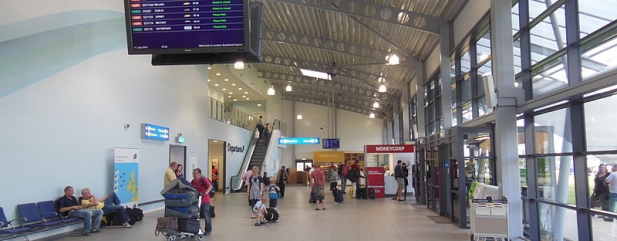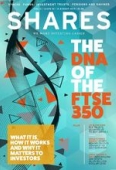Archived article
Please note that tax, investment, pension and ISA rules can change and the information and any views contained in this article may now be inaccurate.
Southend Airport the key to unlocking Stobart's growth potential

Having featured more drama than a soap opera in the last few years, infrastructure and support services firm Stobart Group (STOB) is out to simplify itself.
Formerly of Eddie Stobart trucking fame, those iconic trucks with female names like Tammy, Dolly and Suzie now belong to another company entirely, Eddie Stobart Logistics (ESL:AIM).
Stobart Group on the other hand is now an infrastructure business which wants to become known for two things, London Southend Airport and turning wood into energy.
It sounds a simple enough business, albeit in two very different sectors. But it’s a sign of the company’s narrowing focus, the outcome after a long-running saga in which the firm’s founder Andrew Tinkler was eventually chucked out of the business.
A boardroom bust-up featuring accusations of bullying, lies, ‘flagrant’ breaches of contracts, and ‘malicious falsehoods’ – with Britain’s best known fund manager and shareholder Neil Woodford thrown in for good measure – resulted in Stobart winning a court case in February to remove Tinkler from his job.
Tinkler has since tried to hijack Stobart’s annual general meeting (AGM) with a ‘Save Stobart Group’ campaign which aims to remove chief executive Warwick Brady from his post, arguing that Brady is too focused on the firm’s aviation business ‘to the neglect of the rest of the business’.
While Stobart would undoubtedly argue that is not the case, the company has positioned itself for growth predominantly to come through its aviation division.
SOUTHEND AIRPORT THE MAIN OPPORTUNITY
Stobart believes its best growth opportunity is London Southend Airport, described by broker Jeffries as a ‘scarce asset’.
In the city with the world’s largest airport market by passenger numbers, London Southend is the only of the capital’s six airports which has spare capacity at peak times during the day.
That means Stobart has a great chance to hit its target of 5m passengers travelling through the airport by 2023. The airport currently has around 1.5m passengers last year, which will grow to around 2.2-2.5m this year as Ryanair and Loganair begin flights.
And the reason Stobart wants to get as many passengers in as possible is because that’s where the money is – with the aim of generating £8 in profit per passenger.
That £8 figure comes from a number of things, mainly train income, car parking charges, food and beverages, and airlines paying to use the airport.
Every time a passenger arrives at Southend Airport from London Liverpool Street, Stobart splits the money with train operator Greater Anglia, but receives a majority of the ticket value (the company declined to reveal how much, but said it gets the ‘lion’s share’ of the proceeds). Around one third of passengers at the moment arrive by train.
As passenger numbers grow, Stobart is also looking to increase its number of car parking spaces, up from the current number of 2,000, with the land already available to do so.
It plans to reconfigure and expand its airport to better capitalise on food and beverage opportunities, with the current arrivals section – which makes up one third of the airport space – set to be moved.
A Stobart spokesperson said: ‘You don’t make any money out of arrivals, so one of the options is to build a new arrivals terminals and use that space [where the arrivals section currently is] to significantly increase capacity of the airport.’
Stobart also has a 30% stake in the Connect Airways venture on which it is partnered with Virgin Atlantic and investment firm Cyrus Capital and which encompasses its own Stobart Air business and the assets of regional airline Flybe.
ENERGY BUSINESS
The other main area of Stobart’s business is its energy division. In effect, when businesses want to get rid of their wood, it costs £100 per tonne to put it in landfill, but Stobart will take if off their hands for £30 a tonne. Then they’ll store it, and give it out to renewable energy companies when needed.
A cash generative business, the division has made Stobart the leading supplier of waste wood biomass to UK renewable energy plants, and has around 12 to 15 contracts as a key partner with suppliers according to Jeffries.
In the last financial year to 28 February, it reported earnings before interest, tax, depreciation and amortization (EBITDA) of £19.2m, and has plans to get this up to £25m.
Stobart says it plans to grow the business, which currently generates more revenue and profit than its aviation business, but the main aim is to kick off cash to fund development at Southend Airport, where ultimately the main growth opportunity lies.
FORGOTTEN RAIL DIVISION
While aviation and energy are its two key areas, the business also has legacy divisions which are still kicking about. Civil engineering division Stobart Rail & Civils is one area which could be sold.
Having focused too much on internal work from other Stobart divisions, the business has been reconfigured to win a lot more contracts from third parties, and has a new management team in place to help it achieve that aim.
Stobart’s focus is to move the business to profitability in the near term. As for the medium to long term, the spokesperson said it’s ‘not a core part of the business’, and refused to rule out selling the business if an acceptable offer came in.
The spokesperson added, ‘We want to be a simple business that people can get their heads around, and having loads of divisions isn’t a way to do that.’
Important information:
These articles are provided by Shares magazine which is published by AJ Bell Media, a part of AJ Bell. Shares is not written by AJ Bell.
Shares is provided for your general information and use and is not a personal recommendation to invest. It is not intended to be relied upon by you in making or not making any investment decisions. The investments referred to in these articles will not be suitable for all investors. If in doubt please seek appropriate independent financial advice.
Investors acting on the information in these articles do so at their own risk and AJ Bell Media and its staff do not accept liability for losses suffered by investors as a result of their investment decisions.

 magazine
magazine










